Apollo 12 made space history a long time ago. Best
remembered for lightning striking the giant Saturn 5 rocket after takeoff,
Apollo 12 is also notable for its pinpoint landing next to the abandoned
Surveyor 3 robot spacecraft and for returning a lunar rock, sample 12013, with a
section that was chemically identical to some Australasian tektites found on
Earth. Of the Apollo 12 crew, only Alan Bean and Dick Gordon survive. Astronaut
Pete Conrad, one of the most colorful NASA astronauts from the golden age of
spaceflight, died in a motorcycle accident in 1999.
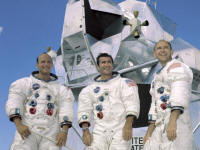 |
(NASA photo of Apollo 12
crew: Left to right are Conrad, Gordon, and Bean)
Today, only Alan Bean actively speaks about the
historic Apollo 12 mission and what it was like to be the fourth man to walk
(more like "hop") on the Moon.
An accomplished artist, Dr. Bean paints lunar and
space scenes both realistic and fanciful; his canvases are highly collectible
and command thousands of dollars at art auctions.
Dr. Bean is a decorated U.S. Navy pilot and aerospace
engineer and was in Vermont last week to accept an honorary doctor of fine arts
degree at Green Mountain College.
I had the honor of meeting Dr. Bean and chatting with
him at the college about the past and future of NASA as well as humans in space.
I presented the former astronaut with a gift copy of my book about lunar
science, titled "Inconstant Moon" (published by Xlibris/Random House); it
discusses some of the unusual lunar rocks returned by the Apollo 12 crew.
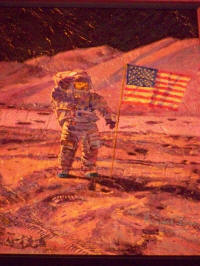 |
(Photo of Alan Bean painting on display at Green
Mountain College, Vermont, taken by Lou Varricchio. Dr. Bean uses some of the
historic tools of his Apollo 12 mission to paint. Even genuine specks of lunar
dust, taken from his lunar EVA suit fabric, are incorporated into the oil and
acrylic paints making Bean canvases highly collectible and valuable.)
VARRICCHIO: Do you believe extraterrestrials have
visited the Earth?
DR. BEAN: No. In all the billions of miles of space,
we’re it. Unlike on T.V. where aliens have landed here or people are waiting for
the aliens to come by—in the real world, they’ll never come by. Here we are;
we’re all there is in this portion of the galaxy. It’s up to us to make the
Earth a great place.
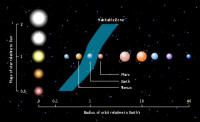 |
(Planetary habitability chart shows where life
might exist on extrasolar planets based on the Solar System and life on Earth.
ESA)
VARRICCHIO: You use realistic and fantasy art as a
means of exploring your off-Earth experiences. Why?
DR. BEAN: I have witnessed things that few humans have
seen. I went to another world and I am an artist. So, when I left NASA in 1980,
I wanted to be true to my creative skills and tell the stories of humanity’s
first adventures off the Earth through visual art. I can celebrate the first
time humans went to another world, the Moon. Yes, we will do it again when we
send humans to land on Mars for the first time. This is what humans do. We
explore new worlds. I explore these new worlds through my art.
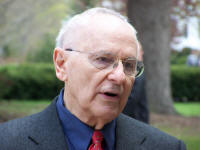 |
(Photo of Alan Bean by Lou Varricchio)
VARRICCHIO: Regarding the Apollo 12 and Skylab 3
missions, what are your fondest memories?
DR. BEAN: Well, not all crews get along like
professional teams. But I was lucky on Apollo 12 in 1969 and Skylab 3 in 1973. I
can honestly say I went on a flight to the Moon with my two best friends, Pete
Conrad and Dick Gordon. It was scary at times, but I had these two great guys by
my side. Jack Lousma and Owen Garriott were with me on SL-3. They were the
rookies and I was the veteran, the commander of that mission. I passed on to
them what Pete and Dick taught me about doing the right things as an astronaut.
I tried to model Pete as Skylab commander. And we were up there for 59 days
doing a lot of good science.
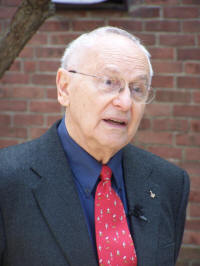 |
(Photo of Alan Bean by Lou Varricchio)
VARRICCHIO: What kind of public support do you see
today regarding human spaceflight?
DR. BEAN: Hey, I thought everybody wanted the most out
of our space program for the good of the nation. But I look around now and it’s
disappointing to me that some politicians are not thinking the same things.
They’re not doing and voting what is best for the country. They do other things.
I’ve been very shocked.
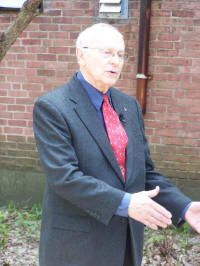 |
(Photo of Alan Bean by Lou Varricchio)
VARRICCHIO Is America on the right track today
regarding humans venturing into space?
DR. BEAN: I do not believe so. In my opinion, NASA
spent a lot of time with the best minds in the scientific community to come up
with a plan to return humans to the Moon and go beyond it (Project Constellation
and the Ares rockets).
NASA had the best hardware under development and the
best people to get the job done. So, for someone to just drop in, spend a little
time thinking and saying ‘Well, I think I’ll change things,’ is very arrogant.
Such a move was not in the best interest of NASA. I
have a lot of confidence in the methodology of NASA to do the best things with
the time and money available.
My heart is in what NASA wanted to do and not with the
people who think they have a "better" idea. Neil Armstrong and Gene Cernan, and
many others, agree with me on this.
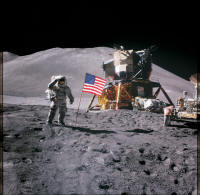 |
(Photo by NASA)
Both Louis Varricchio and Alan Bean are
Ambassadors aboard the USS Phoenix